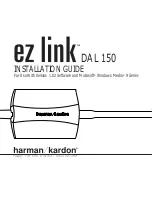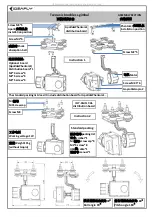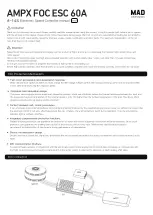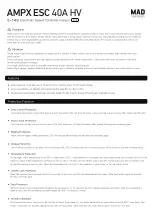
© XPAND, All Rights Reserved.
www.xpandvision.com
Device Mode Control Settings
This section displays and enables modification of settings relating to control of conditions which have to be met in order for the modulator
to transition between 2D and 3D modes.
Mode Control Source:
Defines the mode detection method or in other words the source which determines whether the unit should operate
in 2D or 3D mode. See the
Mode Control Sources
section of this manual for more information on each mode control source.
GPIO Signal Polarity:
Determines how the GPIO mode control source’s input state is interpreted. Normal polarity means that an externally
applied short circuit between pins 3 and 8 sets 3D mode. “Inverted” setting interprets that same short circuit as 2D mode.
3D Sync Low Threshold Frequency:
For “Framesync” mode control source this value sets the minimal frequency at which the incoming
3D synchronization signal is still considered as valid. If the unit is in 3D mode and the frequency is above this limit (and below the high
threshold - see next parameter), the modulator starts its LC shutter and 3D viewing is possible. Valid values are between 24 and 160 Hz with
a requirement that the low threshold frequency is lower than the high threshold frequency - see next parameter.
For “Network” and “GPIO” mode control source this frequency is hardcoded at 20 Hz.
To set the low threshold frequency on the modulator, enter a new value and press the “Enter” key to confirm the change.
3D Sync High Threshold Frequency:
Maximal frequency at which the incoming 3D synchronization signal is still considered as valid. If the
unit is in 3D mode and the frequency is below this limit (and above the low threshold - see previous parameter), the modulator starts its LC
shutter and 3D viewing is possible. Valid values are between 24 and 160 Hz with a requirement that the high threshold frequency is higher
than the low threshold frequency - see previous parameter.
For “Network” and “GPIO” mode control source this frequency is hardcoded at 160 Hz.
To set the high threshold frequency on the modulator, enter a new value and press the “Enter” key to confirm the change.
The Menu Bar
Most of the menu’s items are self-explanatory and intuitive. However the following submenu items deserve some additional explanation:
Restore Default Settings:
Selecting this item enables resetting the currently connected modulator to its default settings. Note that the
network settings remain unchanged and only the “functional” ones are reset. Resetting also the network settings would very likely make
the modulator not accessible on the network without repeating the initial network settings configuration again.
If a reset of network settings is required, a full factory reset of the modulator should be performed. See section
Factory Reset
for instruc-
tions on how that is done.
Check for Updates:
By selecting this submenu item, the application connects to XPAND’s server and checks if any updates are available
for the configuration utility. If a newer version of the utility exists, the user can choose to download and install it. During the installation, the
previous current version will be uninstalled.
It is advised that you regularly check XPAND’s website for new releases, especially if you experience issues with the existing version.
Maintenance
LC Shutter Cleaning
The modulator’s LC shutter should be examined regularly for dirt, dust or stains. A clean LC shutter is important for obtaining a clean and
sharp 3D image.
The preferred method for cleaning the shutter is to use compressed air of low pressure. This removes any dirt and dust.
For removing stains such as fingerprints and smudges clean the LC shutter by wiping the panel lightly with a smooth, dry cloth to prevent
any scratches. If needed, the used cloth can be slightly damp.
After cleaning make sure the panel is still positioned correctly. Check the spirit level for horizontal alignment and use a calibration picture
to fine-tune the position the shutter if necessary.
Fan Air Filter Cleaning and Replacement
The modulator features an easy to replace and clean dust filter which protects the fan cooling the LC shutter. With time the filter can be-
come clogged with dust and other airborne contaminants, which deprive the LC shutter of fresh air required for proper cooling. Insufficient
Содержание MS210C2
Страница 19: ......
Страница 20: ...to be used on dark background to be used on light background...






































